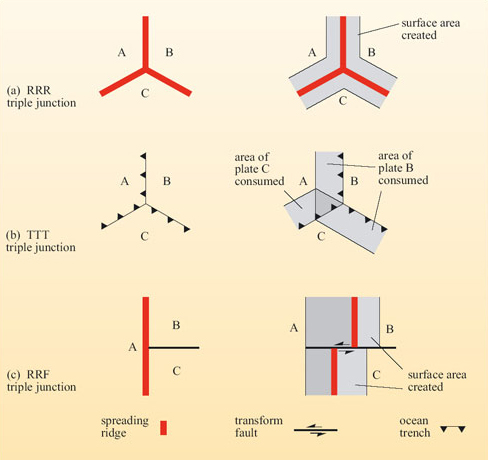3.9 Triple junctions
All of the plate boundaries discussed so far have involved junctions between two plates. However, there are some localities where three plates are in contact, and these are termed triple junctions. Triple junctions between three ocean ridges, such as that in the South Atlantic between the African, South American and Antarctic Plates, are known as ridge-ridge-ridge, or RRR triple junctions. A similar notation can be used to identify triple junctions involving ocean trenches (T) or transform faults (F). For instance, a ridge-ridge-trench junction would be termed an RRT triple junction. The ordering of the letters is not significant. Considering all the geometric possibilities of fitting together three plate boundaries and their relative motions, there are actually only ten possible triple junctions. Some of these, such as RRR junctions, are termed stable triple junctions, which means they maintain their form over time. However, some can only exist briefly before they evolve into another plate configuration and these are termed unstable triple junctions. Figure 21 shows the evolution of three triple junctions over time.

The RRR junction shown in Figure 21a is always stable, regardless of the relative rates of spreading at each of the three ridges. The TTT junction in Figure 21b is basically unstable except if, by coincidence, the movement rates are the same and if the direction of subduction of plate C below plate A is exactly parallel to the boundary between plates B and C. The triple junction in Figure 21c is an RRF junction, and is unstable because there is relative motion between plate B and plate C. The RRF triple junction evolves immediately to form two RFF junctions. FFF and RRF junctions are always unstable.
Seven types of triple junction exist in the present plate tectonic configuration. These are:
-
RRR (e.g. in the South Atlantic, the Indian Ocean and west of the Galapagos Islands in the Pacific)
-
TTT (e.g. central Japan)
-
TTF (e.g. off the coast of Chile)
-
TTR (e.g. off Moresby Island, western North America)
-
FFR, FFT (e.g. junction of the San Andreas Fault and the Mendocino Transform Fault off western USA)
-
RTF (e.g. southern end of the Gulf of California).
